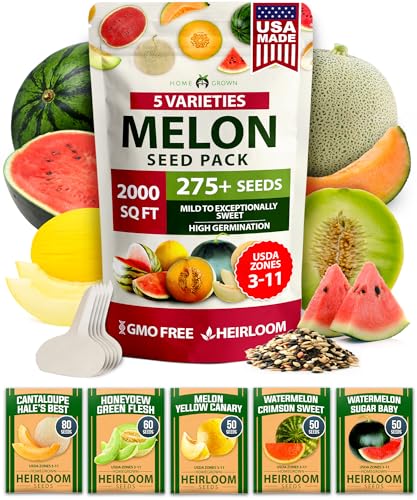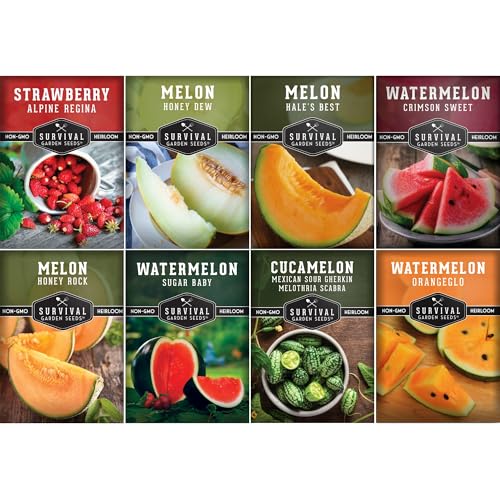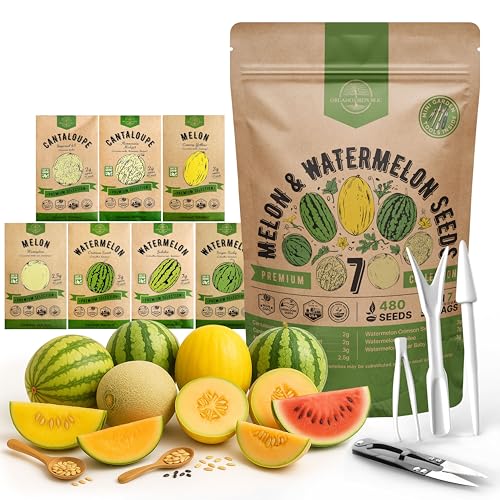Introduction
Melons are among the most rewarding crops you can grow, delivering sweet, refreshing fruit that’s highly valued in farmers’ markets, grocery stores, and home gardens alike. Whether you’re a backyard gardener looking to enjoy homegrown cantaloupe or a commercial farmer exploring profitable warm-season crops, understanding proper melon cultivation techniques is essential for success.
This comprehensive guide walks you through everything you need to know about growing melons, from site selection and soil preparation to variety selection and harvest timing. With the right approach, you can produce abundant, flavorful melons that command premium prices and satisfy even the most discerning palates.
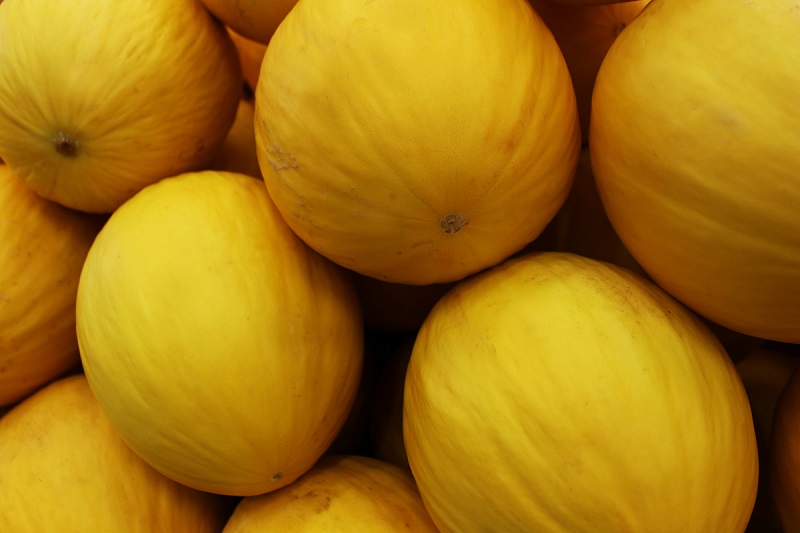
Understanding Melon Plants: The Basics
Melons (Cucumis melo) belong to the Cucurbitaceae family, making them close relatives of cucumbers, squash, and pumpkins. These warm-season vines are prized for their sweet, juicy fruit and relatively straightforward growing requirements.
Melons are heat-loving plants that thrive in warm, dry climates. They develop extensive root systems and sprawling vines that can spread 6-8 feet in all directions. Understanding their growth habits is crucial for planning your garden space and implementing proper cultivation techniques.
Most melon varieties mature in 70-100 days from transplanting, making them an excellent choice for regions with long, hot summers. They’re particularly well-suited to USDA hardiness zones 4-11, with optimal production in zones 5-9.
How to Grow Melons: Step-by-Step Planting Guide
1. Selecting the Perfect Location
Choosing the right site is the foundation of successful melon production. These sun-loving plants have specific requirements that directly impact fruit quality and yield.
Sunlight Requirements: Melons need full sun exposure to thrive. Select a location that receives at least 6-8 hours of direct sunlight daily. More sun exposure translates to sweeter fruit and healthier plants. Southern or western exposures typically provide the best light conditions.
Air Circulation: Good airflow is essential for disease prevention and successful pollination. Choose an open area with moderate air movement, but avoid locations exposed to strong winds that can damage vines or interfere with pollinator activity.
Drainage Considerations: Melons are highly susceptible to root rot and fungal diseases in waterlogged conditions. Avoid low-lying areas where water accumulates. Well-drained soil is non-negotiable for healthy melon production.
Pro Tip: If you’re gardening in areas with heavy clay soil or poor drainage, consider building raised beds 8-12 inches high to ensure optimal growing conditions.
2. Soil Preparation and Fertilization
Soil quality directly impacts melon sweetness, size, and overall plant health. Proper preparation before planting sets the stage for a successful harvest.
Ideal Soil Texture: Melons perform best in sandy loam or loamy soils that are loose and well-aerated. These soil types warm quickly in spring and provide excellent drainage while retaining adequate moisture.
Nutrient Enrichment: Before planting, incorporate 2-4 inches of well-composted organic matter into the top 6-8 inches of soil. Aged manure, compost, or worm castings provide essential nutrients and improve soil structure.
pH Requirements: Melons prefer slightly acidic to neutral soil with a pH between 6.0 and 6.8. Test your soil using a home testing kit or through your local cooperative extension service. If pH adjustments are needed, apply lime to raise pH or sulfur to lower it, following package directions.
Soil Amendments: For heavy clay soils, mix in coarse sand or perlite to improve drainage. Add gypsum to help break up clay particles and improve soil structure without altering pH.
Pre-Planting Fertilization: Apply a balanced fertilizer (10-10-10 or similar) at planting time, following package recommendations. Alternatively, use organic options like fish emulsion or kelp meal for sustainable production.
3. Planting Melons: Seeds vs. Transplants
You can start melons from seed or purchase transplants from a nursery. Each method has advantages depending on your climate and growing season.
Direct Seeding Method:
- Wait until soil temperatures consistently reach 70°F (21°C) or higher
- Create planting hills or mounds 4-6 inches high and 12-18 inches wide
- Plant 2-3 seeds per hill at a depth of ½ to 1 inch
- Space hills 3-4 feet apart in rows 5-6 feet apart
- Germination typically occurs within 5-10 days in warm soil
Transplant Method:
- Start seeds indoors 3-4 weeks before the last frost date
- Use biodegradable pots to minimize transplant shock
- Transplant when seedlings have 2-3 true leaves and soil is warm
- Harden off seedlings for 7-10 days before transplanting
- Plant at the same depth they were growing in containers
Spacing Guidelines: Proper spacing is critical for air circulation and disease prevention. For bush varieties, allow 2-3 feet between plants. For vining types, maintain 3-4 feet between plants with 5-6 feet between rows.
Thinning: After seedlings emerge and develop their first true leaves, thin to the strongest plant per hill. This concentrates nutrients and energy into producing larger, sweeter fruit.
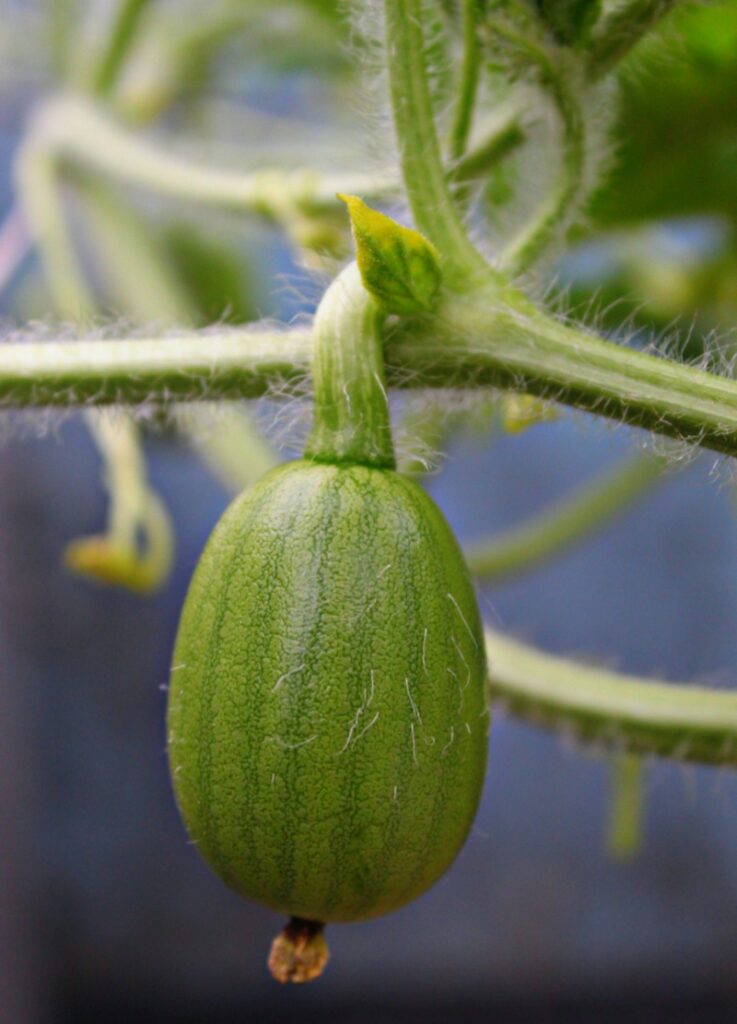
4. Irrigation Management for Sweet Melons
Water management is perhaps the most critical factor in producing sweet, flavorful melons. Understanding when and how much to water makes the difference between mediocre and exceptional fruit.
Early Growth Phase (0-30 days): During establishment, maintain consistently moist soil without waterlogging. Water deeply 2-3 times per week, providing 1-2 inches of water weekly. Focus on developing strong root systems that will support heavy fruit production.
Flowering and Fruit Set (30-60 days): Continue regular irrigation as plants flower and set fruit. Inconsistent watering during this phase can cause blossom end rot or fruit cracking. Maintain soil moisture at 60-80% of field capacity.
Fruit Development (60-80 days): As melons approach full size, gradually reduce watering frequency. Slight water stress during the final 2-3 weeks before harvest concentrates sugars, resulting in sweeter, more flavorful fruit.
Irrigation Methods:
- Drip irrigation: Most efficient method, delivering water directly to root zones while keeping foliage dry
- Soaker hoses: Good alternative for small plantings, providing slow, steady moisture
- Furrow irrigation: Traditional method suitable for larger commercial operations
- Overhead sprinklers: Least desirable due to increased disease risk from wet foliage
Water Quality Considerations: In arid regions with high salinity water, monitor electrical conductivity (EC) levels. Melons are moderately sensitive to salt, with yield reductions occurring above 2.2 dS/m.
Pollination and Fruit Set
Successful pollination is essential for melon production. Melons produce separate male and female flowers on the same plant, requiring pollinators to transfer pollen between flowers.
Natural Pollination: Honeybees, native bees, and other insects are primary pollinators. In commercial operations, placing bee hives near melon fields at a rate of 2-3 hives per acre significantly improves pollination rates and fruit quality.
Hand Pollination: In areas with limited pollinator populations, hand pollination ensures fruit set. Using a small brush or cotton swab, transfer pollen from male flowers (those with thin stems) to female flowers (those with small fruit at the base). Early morning is the best time for this activity.
Pollination Challenges: Extreme heat above 95°F (35°C), high humidity, or pesticide use during flowering can reduce pollinator activity and impact fruit set.
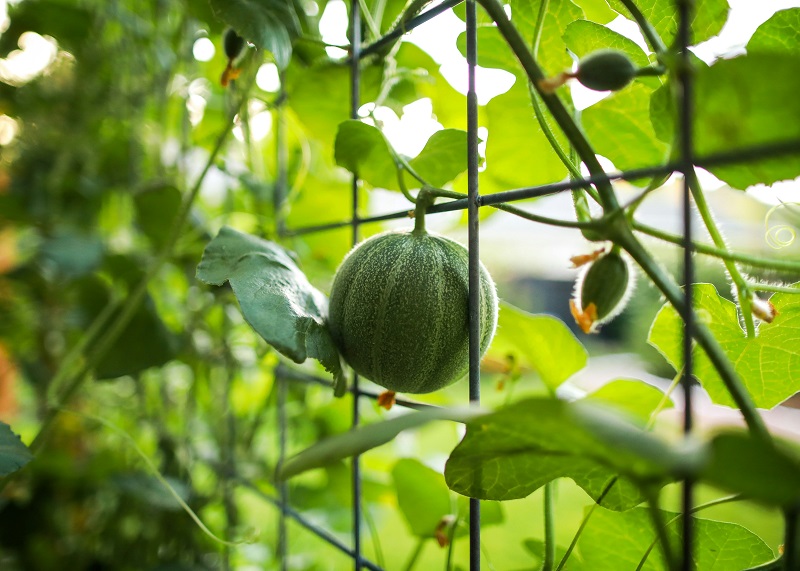
Climate and Growing Season Requirements
Melons are definitively warm-season crops with specific temperature requirements for optimal production.
Temperature Range:
- Optimal growing temperature: 75-85°F (24-30°C)
- Minimum soil temperature for planting: 70°F (21°C)
- Germination temperature: 80-90°F (27-32°C)
- Frost tolerance: None—plants are killed by even light frost
Regional Adaptations:
- Southern states (zones 8-10): Plant from March through July for multiple harvests
- Mid-Atlantic and Midwest (zones 5-7): Plant after last frost, typically May-June
- Northern regions (zones 3-4): Use black plastic mulch and row covers to extend season
- Southwest desert regions: Ideal climate with hot, dry conditions; plant February-April and August-September
Season Extension Techniques:
- Use black plastic mulch to warm soil 5-10°F
- Install row covers or low tunnels for frost protection
- Select short-season varieties (70-80 days) for northern regions
- In hot climates, provide afternoon shade to prevent sunscald
Common Pests and Diseases Affecting Melons
Proactive pest and disease management is essential for producing high-quality melons.
Major Pests
Aphids: Small, soft-bodied insects that cluster on undersides of leaves, sucking plant sap and transmitting viral diseases. Control with insecticidal soap, neem oil, or beneficial insects like ladybugs.
Cucumber Beetles: Striped or spotted beetles that feed on leaves, flowers, and fruit while spreading bacterial wilt. Use row covers during early growth, handpick adults, and apply kaolin clay as a deterrent.
Squash Vine Borers: Larvae tunnel into stems near the base, causing sudden wilting. Wrap stem bases with aluminum foil, make weekly inspections, and remove infected vines promptly.
Spider Mites: Tiny arachnids causing stippled, yellowing leaves in hot, dry conditions. Increase humidity, spray with water, or apply horticultural oil.
Common Diseases
Powdery Mildew: White, powdery fungal growth on leaves reducing photosynthesis. Prevent by ensuring good air circulation, avoiding overhead watering, and applying sulfur-based fungicides or potassium bicarbonate.
Downy Mildew: Yellow patches on upper leaf surfaces with gray-purple growth underneath. Use resistant varieties, improve air circulation, and apply copper-based fungicides.
Fusarium Wilt: Soil-borne fungal disease causing yellowing and wilting. Plant resistant varieties, practice crop rotation (avoid planting cucurbits in the same location for 3-4 years), and ensure proper drainage.
Anthracnose: Fungal disease causing dark, sunken lesions on fruit. Prevent with crop rotation, avoid overhead irrigation, and apply appropriate fungicides.
Prevention Strategies:
- Use plastic or organic mulch to prevent soil-borne diseases from splashing onto fruit
- Space plants adequately for air circulation
- Water at soil level rather than overhead
- Remove and destroy infected plant material promptly
- Rotate crops annually
Popular Melon Varieties for American Growers
Selecting the right variety for your climate and market is crucial for success. Here are the most popular types grown in the United States.
1. Cantaloupe (Muskmelon)
The most widely grown melon type in North America, true cantaloupes have netted, tan rinds and orange flesh with an intensely sweet, aromatic flavor.
Popular Cultivars:
- Athena: Industry standard with excellent disease resistance and consistent quality (80-85 days)
- Ambrosia: Exceptionally sweet with small seed cavity (86 days)
- Hale’s Best Jumbo: Heirloom variety reliable in various climates (85-90 days)
Market Appeal: High demand in farmers’ markets and grocery stores. Premium prices for organic production.
2. Honeydew
Smooth-skinned melons with pale green to white flesh and subtle, honey-like sweetness.
Popular Cultivars:
- Honey Gold: Golden rind with white flesh, early maturing (80 days)
- Orange Dew: Orange flesh variety with excellent storage (105 days)
- Earli-Dew: Compact plants suitable for small gardens (80-85 days)
Growing Notes: Requires slightly longer season than cantaloupe. Harvest when rind turns creamy yellow.
3. Galia Melon
Israeli variety gaining popularity in the US, featuring netted golden rinds and light green, extremely sweet flesh.
Characteristics:
- Earlier maturity than most melons (75-85 days)
- Aromatic with tropical fruit notes
- Good disease resistance
- Excellent shelf life
Market Potential: Growing specialty market demand, particularly in upscale grocery stores and restaurants.
4. Charentais Melon
French variety prized by gourmet chefs for intense flavor and aromatic qualities.
Characteristics:
- Small, personal-sized melons (2-3 pounds)
- Smooth, gray-green rind with subtle ribbing
- Deep orange flesh with exceptional sweetness
- Shorter shelf life than other varieties (80-90 days)
Best Use: Specialty markets, farm stands, and direct-to-consumer sales where freshness is prioritized.
5. Crenshaw Melon
Hybrid between cantaloupe and casaba with distinctive pointed stem end.
Characteristics:
- Large fruit (8-10 pounds)
- Golden-green skin with salmon-pink flesh
- Spicy-sweet flavor profile
- Later maturity (110-120 days)
Growing Requirements: Needs long, hot season. Best suited to California and southwestern states.
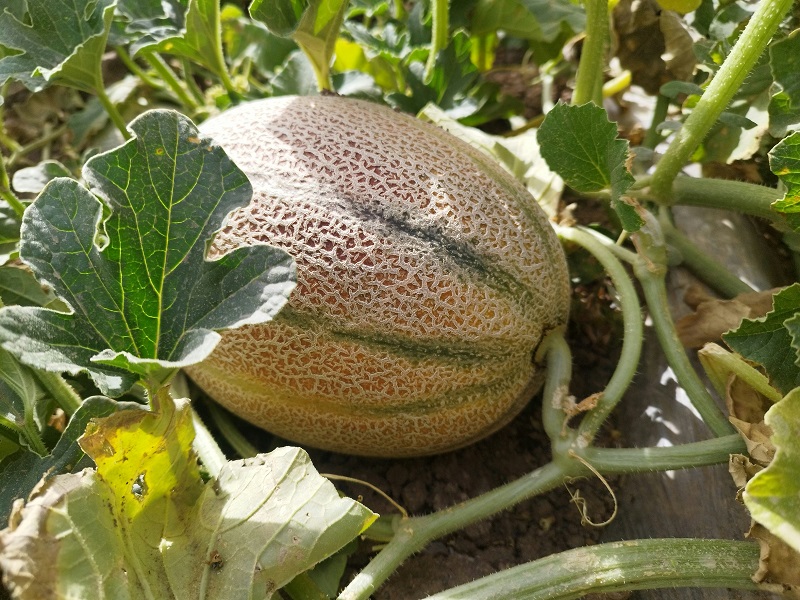
When and How to Harvest Melons
Timing harvest correctly is crucial for optimal sweetness and flavor. Unlike some fruits, melons don’t continue ripening after harvest, though they may soften slightly.
Determining Ripeness
Visual Indicators:
- Color change: Ground spot (where melon rests on soil) turns from white to creamy yellow
- Netting: On netted varieties, netting becomes more pronounced and cork-like
- Stem condition: For cantaloupes, stem begins to separate from fruit (half-slip to full-slip stage)
Physical Tests:
- Aroma: Sweet, musky fragrance develops near the stem end
- Texture: Slight softening at blossom end when gently pressed
- Sound: Hollow sound when tapped (less reliable than other methods)
Varietal Differences:
- Cantaloupe: Harvest at full-slip (stem separates cleanly with gentle pressure)
- Honeydew: Does not slip; harvest when skin turns creamy and slight softening occurs at blossom end
- Watermelon: Tendril nearest fruit turns brown and dry; underside turns creamy yellow
Harvest Timing
Most melons mature 70-100 days after transplanting, depending on variety and weather conditions. Check fields or gardens every 2-3 days during harvest season, as melons ripen quickly.
Time of Day: Harvest in the morning after dew dries but before temperatures peak. This is when sugar content is highest and fruit is firmest.
Handling: Cut stems with pruning shears rather than pulling fruit. Handle gently to avoid bruising, which reduces shelf life and market value.
Post-Harvest Care
Storage:
- Do not wash melons before storage, as moisture promotes decay
- Store at 36-45°F (2-7°C) with 90-95% relative humidity
- Cantaloupe: 7-14 days storage life
- Honeydew: 14-21 days storage life
- Keep away from ethylene-producing fruits (apples, bananas) which accelerate ripening
Commercial Considerations: For market sales, harvest slightly under-ripe to account for transport time. Melons shipped long distances should be harvested at three-quarter slip for cantaloupes.
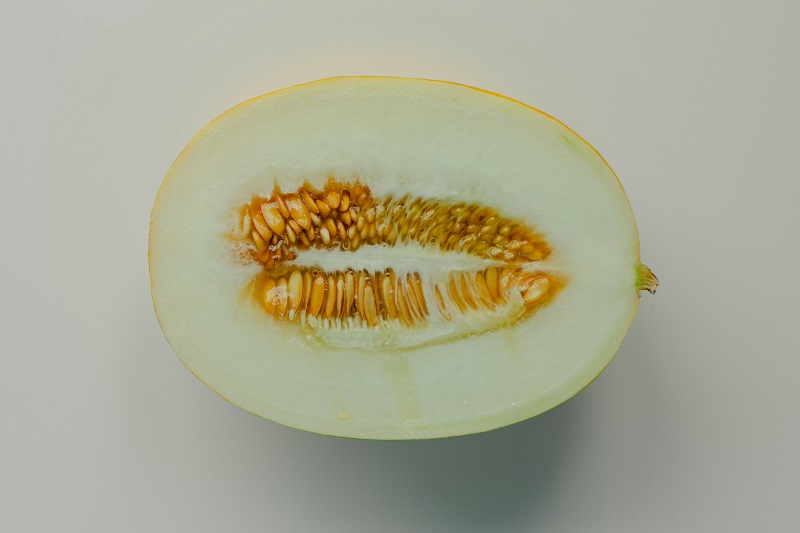
Commercial Melon Production Strategies
For growers considering melons as a commercial crop, understanding production economics and best practices is essential for profitability.
Production Systems
Drip Irrigation with Plastic Mulch: Industry standard combining water efficiency with weed control and earlier harvests. Black plastic warms soil and advances maturity by 7-14 days.
High Tunnel Production: Extends season in northern regions and protects from environmental stress. Requires careful temperature and humidity management to prevent disease.
Field Production: Traditional method suitable for large acreages in warm climates. Lower initial investment but requires more intensive weed and pest management.
Economic Considerations
Yield Expectations:
- Cantaloupe: 8,000-12,000 melons per acre (15,000-25,000 pounds)
- Honeydew: 10,000-15,000 pounds per acre
- Specialty varieties: Generally lower yields but premium prices
Market Outlets:
- Farmers’ markets: Highest retail prices ($3-6 per melon)
- Wholesale: Lower prices but larger volumes ($0.50-2 per pound)
- U-pick operations: Lower labor costs, good customer engagement
- Restaurants and specialty stores: Premium prices for quality and unique varieties
Cost Considerations: Factor in seed/transplants ($100-300/acre), plastic mulch and drip tape ($400-600/acre), fertilizer ($150-300/acre), and significant harvest labor costs.
Crop Rotation
Melons benefit from 3-4 year rotations with non-cucurbit crops to reduce disease pressure and maintain soil health.
Good Rotation Crops:
- Sweet corn or grain crops
- Legumes (beans, peas) for nitrogen fixation
- Brassicas (broccoli, cabbage)
- Small grains or cover crops
Avoid Following: Other cucurbits (cucumbers, squash, pumpkins) or solanaceous crops (tomatoes, peppers) that share pest and disease pressures.
Cover Cropping: Plant winter rye or other cover crops after melon harvest to prevent erosion, suppress weeds, and add organic matter.
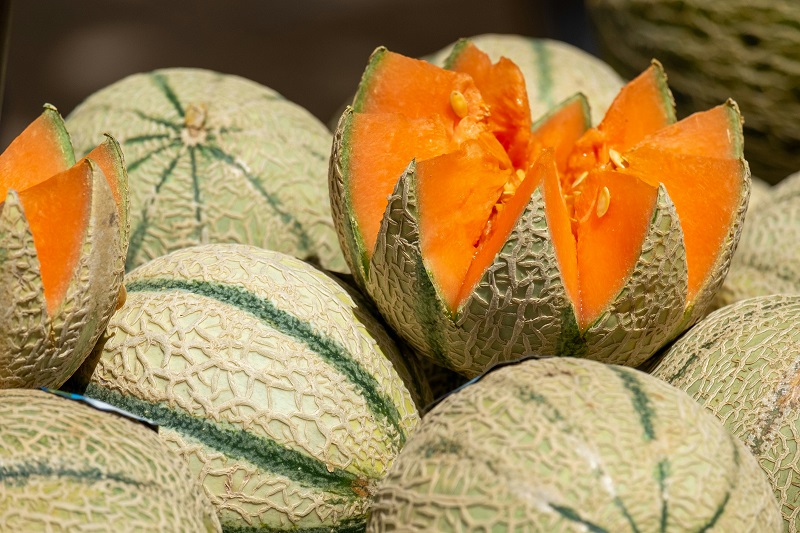
Sustainable Growing Practices
Modern melon production increasingly incorporates sustainable practices that benefit both productivity and environmental stewardship.
Water Conservation:
- Use drip irrigation to reduce water consumption by 30-50% compared to overhead systems
- Implement soil moisture sensors for precise irrigation scheduling
- Apply mulch to reduce evaporation
Integrated Pest Management (IPM):
- Scout fields regularly to identify problems early
- Use pheromone traps for monitoring pest populations
- Encourage beneficial insects through habitat creation
- Apply pesticides only when economic thresholds are reached
Soil Health:
- Maintain organic matter through compost additions and cover cropping
- Minimize tillage to preserve soil structure
- Use crop rotation to break pest cycles naturally
- Consider no-till or reduced-till systems with permanent raised beds
Pollinator Support:
- Plant flowering borders to support native bee populations
- Avoid pesticide applications during bloom periods
- Maintain habitat areas with diverse flowering plants
Troubleshooting Common Melon Growing Problems
Problem: Poor fruit set
Causes: Inadequate pollination, extreme temperatures, nitrogen excess
Solutions: Encourage pollinators, hand pollinate if necessary, reduce nitrogen fertilization
Problem: Small, misshapen fruit
Causes: Water stress, poor pollination, nutrient deficiency
Solutions: Maintain consistent moisture, ensure adequate pollination, apply balanced fertilizer
Problem: Fruit cracking
Causes: Irregular watering, excessive rain near maturity
Solutions: Maintain consistent irrigation, reduce watering as harvest approaches
Problem: Low sugar content
Causes: Overwatering near harvest, inadequate sunlight, premature picking
Solutions: Reduce irrigation final 2-3 weeks, ensure full sun exposure, harvest at proper maturity
Problem: Sudden plant wilting
Causes: Vine borers, bacterial wilt, fusarium wilt
Solutions: Inspect stems for borer damage, control cucumber beetles (wilt vectors), plant resistant varieties
Frequently Asked Questions
How long does it take to grow melons?
Most melon varieties mature in 70-100 days from transplanting, with cantaloupes typically ready in 75-85 days and honeydews requiring 85-105 days.
Can I grow melons in containers?
Compact or bush varieties can be grown in large containers (at least 5 gallons) with excellent drainage. Provide sturdy trellising for vine support.
Why are my melons not sweet?
Common causes include overwatering near harvest, inadequate sunlight, harvesting too early, or cool growing temperatures below 75°F.
Do melons need a trellis?
While not necessary, vertical growing on trellises saves space and improves air circulation. Support developing fruit with slings to prevent stem damage.
How many melons per plant?
Cantaloupe plants typically produce 2-4 full-sized melons. For larger fruit, thin to 2-3 melons per plant once fruit reaches tennis ball size.
Conclusion: Growing Melons Successfully
Growing melons offers rewarding opportunities for both home gardeners and commercial farmers. These versatile crops provide sweet, nutritious fruit with strong market demand and premium pricing potential when grown properly.
Success with melons comes down to understanding their fundamental requirements: warm temperatures, full sun exposure, well-drained soil, consistent moisture management, and proper variety selection for your climate. By implementing the techniques outlined in this guide—from soil preparation and planting through pest management and harvest timing—you’ll be well-equipped to produce high-quality melons that satisfy customers and generate profits.
Whether you’re growing a few plants in your backyard or managing acres of commercial production, the principles remain the same. Start with healthy soil, provide optimal growing conditions, monitor for problems, and harvest at peak ripeness for the sweetest, most flavorful fruit possible.
Ready to start your melon growing journey? Begin by selecting varieties suited to your region and preparing your planting site. With attention to detail and proper care, you’ll soon be enjoying the sweet rewards of homegrown melons.

